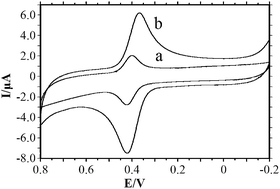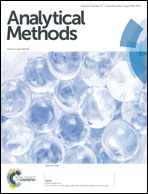Electrochemical behavior of luteolin on a chitosan–graphene modified glassy carbon electrode and its sensitive detection†
Abstract
A simple and highly sensitive electrochemical method was developed for the determination of luteolin based on the chitosan–graphene (GR) modified glassy carbon electrode. Due to the specific characteristics of GR present on the electrode surface, the electrochemical response of luteolin on the modified electrode was greatly enhanced with the appearance of a pair of well-defined redox peaks. The results were attributed to the large surface area and high conductivity of GR with the considerable improvement of the redox peak current, which allowed the development of a highly sensitive voltammetric sensor for the determination of luteolin. Under the optimized conditions the oxidative peak currents increased linearly with the concentration of luteolin in the range from 2.0 nmol L−1 to 60.0 μmol L−1, with a detection limit of 5.93 × 10−10 mol L−1 (3S0/S). The analytical performance of this sensor has been evaluated for the detection of luteolin in Duyiwei capsules as a real sample with satisfactory results.


 Please wait while we load your content...
Please wait while we load your content...